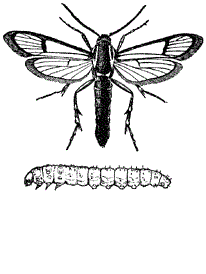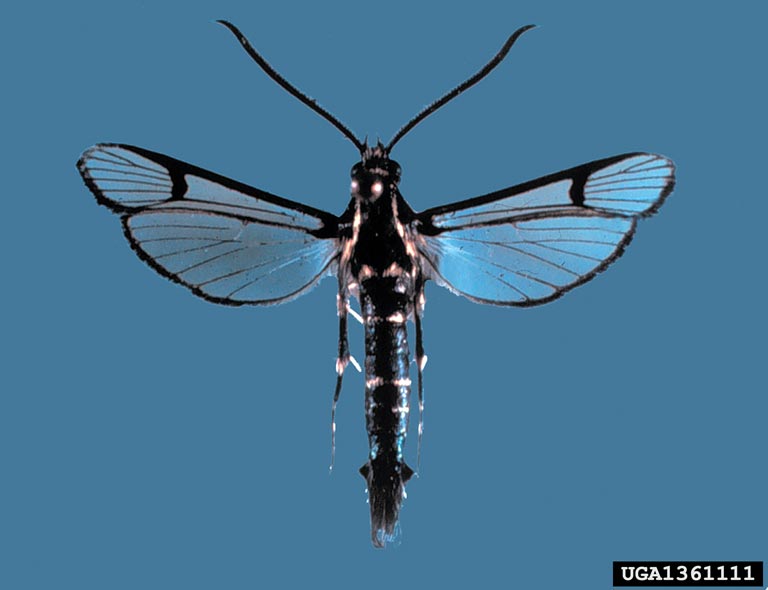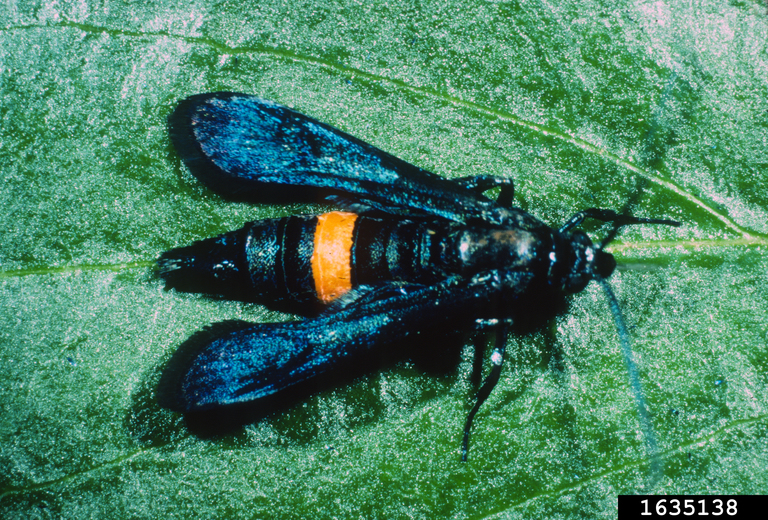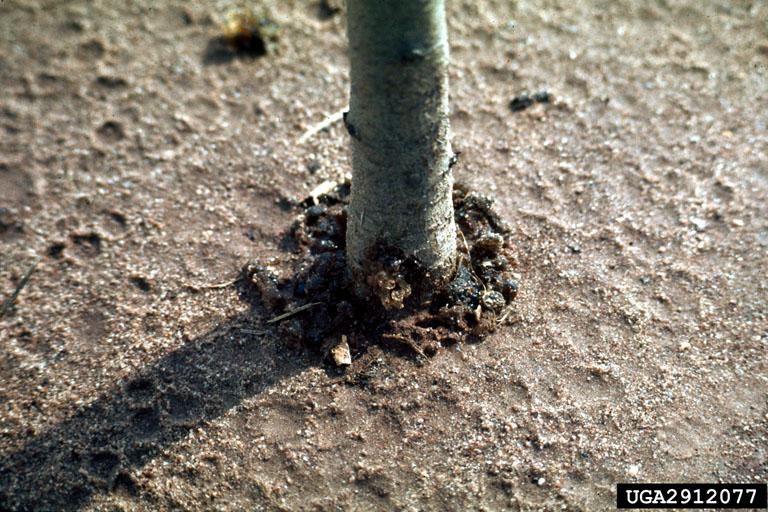 Peach Tree Borers - February 22, 2017 Jeff Schalau, Agent, Agriculture & Natural Resources University of Arizona Cooperative Extension, Yavapai County Peach tree borers are native insects that would normally colonize native Prunus species. The cause serious damage to the lower trunk and can kill young peach trees if left unchecked. Commercial and backyard orchards having peach, nectarine, plum, cherry, apricot and almond trees are susceptible. Now is the time to inspect your trees for damage and apply one of the treatments outlined below. Adult peach tree borers (Synanthedon exitiosa) are steel blue to black moths with transparent wings that emerge in the late spring and early summer. They have an orange band on their abdomen and this causes them to resemble a wasp. Females lay their eggs during summer, usually starting in June through August, on the bark at the base of tree trunks. After hatching, the larvae tunnel into the sapwood of the tree at or slightly below ground level. The larvae (caterpillars) are light brown or pinkish with a slightly darker head. Larvae feed under the bark through the summer, and move down the trunk as cold weather approaches. The partially grown larvae resume feeding in the spring. Pupation takes place under the bark, and lasts about two weeks. Moths begin to emerge in late spring, at which time mating takes place and the cycle repeats. Their feeding girdles the tree, disrupting the flow of water and nutrients in the xylem and organic compounds in the phloem. Insecticide applications can be effective at controlling the early larval stages. Peach tree borers can be controlled by insecticides that contain carbaryl, permethrin or esfenvalerate. These insecticides are available in some garden centers and on-line (read the label to ensure the product is labeled for edible fruit). In older references, naphthalene crystals (mothballs or moth crystals) are often listed as a chemical control. Since naphthalene crystals are not labeled for this use, it is no longer a recommended practice due to environmental concerns. An environmentally-friendly method of peach tree borer control uses the insect parasitic nematode Steinernema carpocapsae. Parasitic nematodes are tiny roundworms and available from biocontrol catalogs. This species parasitizes the peach tree borer larvae. Nematode applications are most effective when larvae are feeding actively and tunnel openings are largest in late summer. The nematodes are applied with a squeeze bottle in suspension with water. This method is not as effective as pesticide treatment, but it will work if applied with sufficient water to moisten the soil and temperatures are above 50 degrees F. The best preventative treatment for any pest species is proper care. You simply maintain the highest level of thrift and vigor in your orchard. Fertilize, water, avoid sunscald, prune, control weeds, and lastly, observe the trees for early signs of pest infestations. See photos and additional resources below. Follow the Backyard Gardener on Twitter – use the link on the BYG website. If you have other gardening questions, call the Master Gardener help line in the Camp Verde office at 928-554-8992 or e-mail us at verdevalleymg@gmail.com and be sure to include your name, address and phone number. Find past Backyard Gardener columns or provide feedback at the Backyard Gardener web site: http://cals.arizona.edu/yavapai/anr/hort/byg/. Photos  Peachtree borer (Synanthedon exitiosa) adult male (Wendell Snow, USDA Agricultural Research Service, Bugwood.org).  Peachtree borer (Synanthedon exitiosa) adult female (J.A. Davidson, Univ. Md, College Pk, Bugwood.org).  Peachtree borer (Synanthedon exitiosa) larvae (Wendell Snow, USDA Agricultural Research Service, Bugwood.org).  Peachtree borer (Synanthedon exitiosa) damage as it often appears on the soil surface (Eugene E. Nelson, Bugwood.org). Additional Resources Peach Tree Borer Colorado State University Extension extension.colostate.edu/topic-areas/insects/peach-tree-borer-5-566/ Peach Tree Borer Utah State University Extension extension.usu.edu/pests/ipm/notes_ag/fruit-gptb |